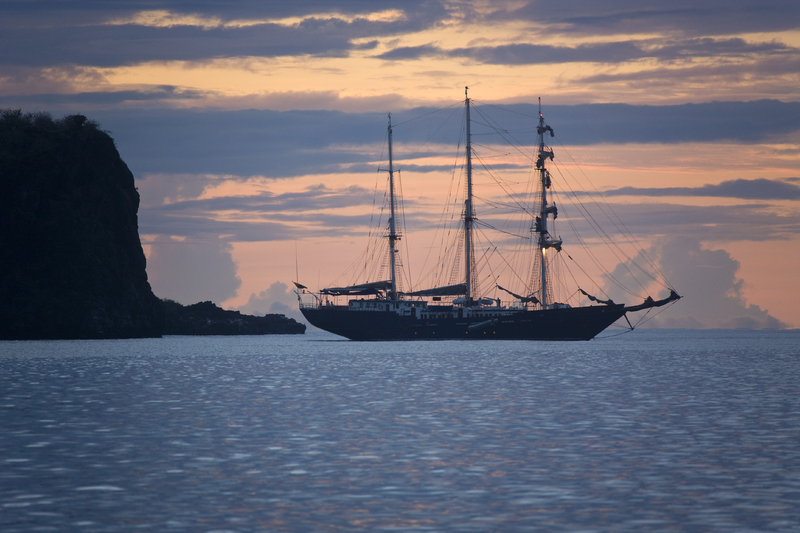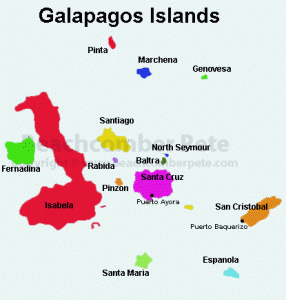The oldest island in the Galapagos Archipelago is Espanola Island. It is also known as Hood Island, and is a 10 to 12 hour boat ride from Isla Santa Cruz. Those planning to travel to this area should be aware that during the months of August and September the seas could be quite rough near the island. Espanola was formed through volcanic action, as were all of the Galapagos Islands. It is the oldest of the islands and testing revealed that the lava here is around 3.4 million years old. Today, the volcano on Espanola is extinct and because it is a rather low island, it is dry and quite inhospitable. However, this island is still a very popular tourist spot.
 Because of Espanola’s hostile environment and lack of a large amount of fresh water, there are no settlements on the island. However, it is due to this lack of interference from humans that certain wildlife has been able to thrive by adjusting to the environment of the island.
Because of Espanola’s hostile environment and lack of a large amount of fresh water, there are no settlements on the island. However, it is due to this lack of interference from humans that certain wildlife has been able to thrive by adjusting to the environment of the island.
For instance, the Marine Iguana from Espanola is the only one that changes its colors during breeding season, unlike those on the other Galapagos Islands. Normally, the iguanas are black, allowing them to hide in the black lava on each of the islands. However, the Espanola Marine Iguana is a reddish color, except during breeding season when it is a greenish shade.
The Hood Mockingbird is another animal that is endemic to Espanola. This bird is not afraid of visitors and at times even lands on a visitor’s head. In addition, it is the only carnivorous species of Mockingbird, thriving on a diet of insects and turtle hatchlings.
At one point, the Saddleback Tortoises of Espanola nearly went extinct. By 1959, there were only 12 females and 2 males left on the island. In the 1960’s, scientists brought these tortoises, along with another male tortoise from a U.S. zoo, to the Darwin Breeding Center where a captive breeding program began. Today, because of the success of that program, there is again a growing population of the Espanola Saddleback Tortoises.
Espanola’s greatest highlight is its many species of birds. The steep volcanic cliffs make perfect homes for many of them. The most popular, and one endemic to the island, is the Waved Albatross. The island has the largest population of these birds whose nests can be found only on Espana. It is quite a sight when these birds, with their enormous wingspan, take off from the high cliffs on their way to their feeding grounds. Those who enjoy bird watching will be thrilled by the variety of birds here including the Galapagos Hawks, Masked Boobies, Swallow Tailed Gulls and the Red Billed Tropic Bird.
Espanola has two visitor sites, Punta Suarez and Gardener Bay. Punta Suarez is on the western end of the island. Travelers must make a wet landing here. Walking along a two-mile trail, the visitor will be able to see sea lions playing in the water, numerous birds cavorting in the sky, and the largest Marine Iguanas in the Galapagos. This area is also home to the Espanola Lava Lizards, as well as birds such as the Galapagos Doves, the Large Billed Flycatcher, the Galapagos Hawk and the always popular Waved Albatross.
On the east side of Espanola is Gardiner Bay. This area is a popular site for swimming and snorkeling. Its white sand beach makes this the perfect spot to relax and enjoy the surroundings. There are colonies of sea lions who like to sun themselves on the beach, as well Green Sea Turtles just off shore. Nothing can beat snorkeling in Gardener Bay with the sea lions swimming right alongside. Out a little further, there are large schools of colored tropical fish along with an occasional Manta Ray and White Tipped Shark.
Although Espanola is not habitable according to human standards, it is the perfect home for a unique group of animals. They have been able to adapt to extreme conditions and many exist only on this island. A visit to Espanola allows the traveler to view an area unchanged by man, something that is becoming rarer as time goes by.







